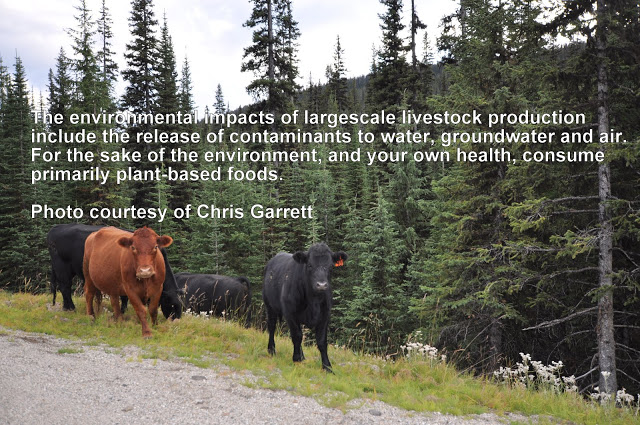There is a tendency for people to think that the contributions that we, as individuals, make to contaminant releases to the environment are small in comparison to other sources and that changes made on an individual basis would not result in significant improvements. But if we can become more aware of our own contributions to the overall problem and make even a few small concessions to our daily activities and choices, the combined effects of these seemingly small actions would benefit both our own health and the health of our environment.
Some examples of ways in which we can reduce our releases of contaminants to the environment include:
- Reduce or eliminate the use of potentially harmful chemicals in your garden. In many municipalities within the Georgia Basin, the residential use of cosmetic pesticides is now prohibited. For more information on bylaws on pesticide use and sales in your area, refer to your municipality’s website.
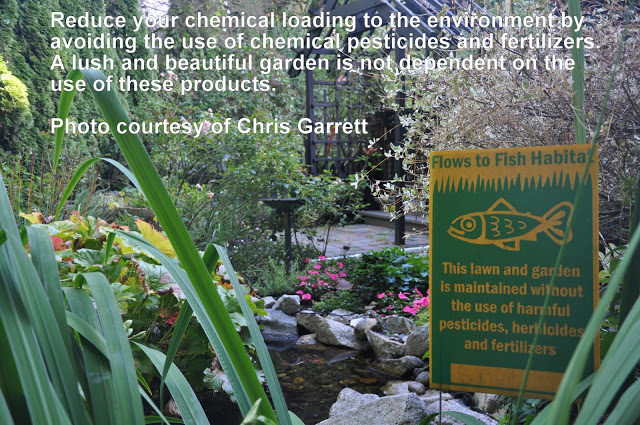
- Use natural methods of pest control for those few species that do cause problems. But, keep in mind that the vast majority of insects in your garden including spiders, ladybugs, bees, parasitic wasps, ground beetles, dragonflies, butterflies, lacewings, and sowbugs are beneficial or harmless. Also, be aware that many species of caterpillars are relatively harmless to gardens and will transform into beautiful butterflies and moths. Before eliminating caterpillars from your garden, teach yourself to differentiate between the harmful and harmless ones. Beneficial insects, which can help control harmful insects, can be purchased at many garden centres. In addition, birds and bats consume tens of thousands of insects and are important in keeping nuisance insect species under control. You can atttract beneficial insects, birds and bats into your yard by planting the types of vegetation that they prefer and also by installing bird and bat houses.

- Reduce the use of products which contain potentially harmful chemicals in your home by choosing more environmentally-friendly cleaning products. Some of the chemicals present in cleaning products are not broken down in municipal wastewater treatment plants and can be detrimental when discharged to the environment. In addition, many people have health-related sensitivities to traditional commercial cleaners. However, many greener products are now available for sale, or you can make your own cleaning products easily and inexpensively from common household items such as baking soda, pure soap, white vinegar, borax, and salt. In addition, a number of natural products have antiseptic and antifungal properties. These include grapefruit extract and essential oils of lavender, cloves and tea tree oil.
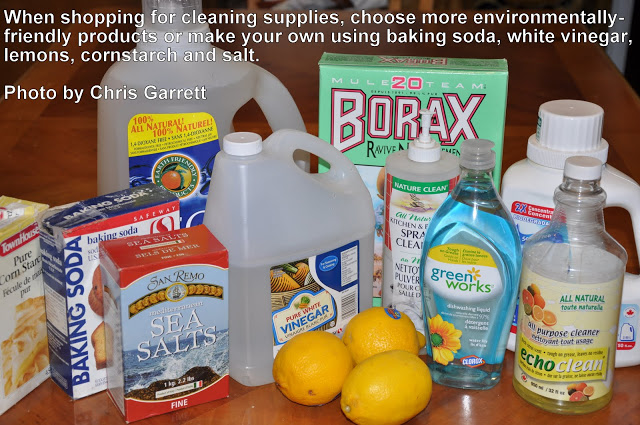
- Take advantage of the many recycling programs which are now in place in all municipalities. The disposal of waste in landfills results in the release of contaminants to the environment. Many municipalities arrange for the curbside pickup of recyclables such as newspapers, glass, beverage containers, and some plastics. Other products, such as chemicals, pesticides, solvents, paints, electronics, and batteries must be taken to recycling centers. The Recycling Council of British Columbia provides information on recycling programs and options. Check your muncipality’s website to more information on curbside recycling.

- Never discard pharmaceuticals in the sink or toilet. Return them to the pharmacy for safe disposal. Also, familiarize yourself with the names of the potentially harmful ingredients which are contained in many personal care products including soaps, deodorants, hair products, sunscreens, lotions, cosmetics, fragrances and dental products. Choose products which are free of these ingredients. A wide range of chemicals enter the environment as a result of the use and disposal of pharmaceuticals and personal care products (PPCPs). PPCPs are tested to ensure their safety when used for the purposes for which they were designed. However, their effects on non-target organisms in the environment are often not well understood and even low concentrations of some PPCPs have been shown to have adverse effects on aquatic species.
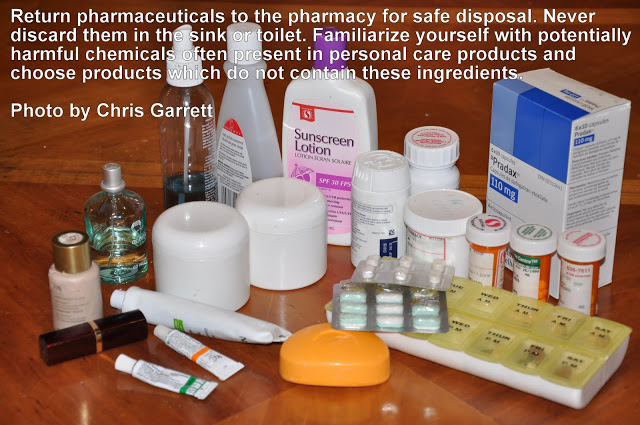
- Never allow chemicals or contaminants of any type or pet fecal matter to enter street gutters or storm drains. Storm drains collect rainwater from roadways, parking lots, driveways, and sidewalks. In most cases, the stormwater is not treated or filtered before being released to local waterways. Common contaminants in stormwater include pesticides, nutrients, particulates, detergents, petroleum compounds, PAHs, oils, fuel, and metals. Sources of contaminants to storm drains include vehicle exhaust; the wearing of vehicle parts such as brakes and brake linings; car washing; spills of fuel, oil and other materials; the use of pesticides and fertilizers; and atmospheric deposition. Stormwater can also be a signifiant source of pathogens to the environment. Pet feces deposited on roads, sidewalks, boulevards, and near ditches can be washed into storm drains and ditches and transported to localwaterways. These pathogens pose a hazard to both environmental and human health. It is important to pick up and properly dispose of your pet’s fecal material.
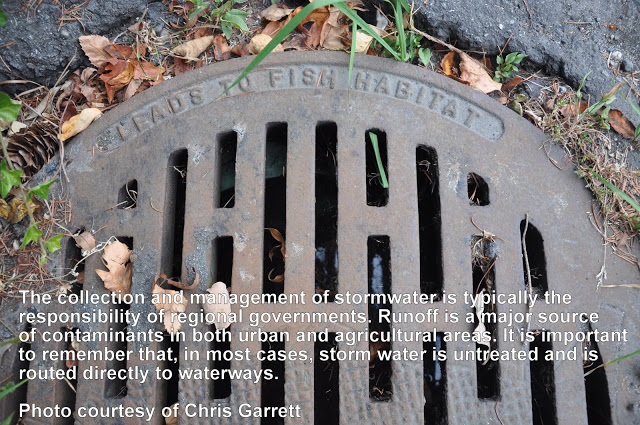
- Whenever possible, utilize more environmentally friendly means of transportation. Vehicle exhaust is a significant source of contaminants to the air in urban areas. In addition, contaminants in vehicular emissions, oils, etc. are washed off roadways by stormwater and then released to nearby waterways by storm water systems. Walking, biking, public transport and carpooling are all ways in which we can reduce transportation related releases of contaminants to the environment.
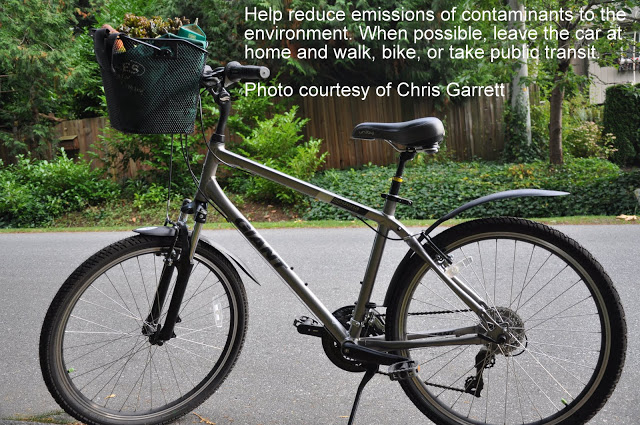
- Buy organic foods (or better still, grow your own). The organic production of foods promotes environmental health for a variety of reasons. Organic farming does not rely on the use of chemical pesticides and fertilizers and, as a result, results in lower concentrations of contaminants in both food and the local environment. Support your local organic farmers who are doing their part to reduce human exposure to pesticides through food sources and also to reduce the loadings of these contaminants to the environment.
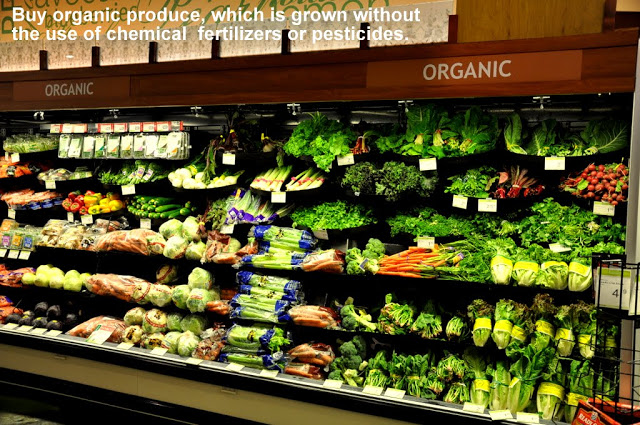
- Consider vegetarianism or, at least, significantly decrease your consumption of animal-based foods. It’s important to think about where your food comes from and how it’s produced. The industrialization of food production, and in particular meat production, seriously impacts the environment globally. Among the many environmental impacts of largescale livestock production is the release of contaminants such as nutrients, pathogens and veterinary drugs. In addition, the gases released by livestock contribute to climate change (United Nations 2006; United Nations 2013).
- The United Nations (UN) predicts that environmental pressures caused by the consumption of animal products will increase significantly in the future as the world population increases. A UN report states “a substantial reduction of impacts would only be possible with a substantial worldwide diet change, away from animal products” (United Nations 2010). Similarly, Tilman and Clark (2014) and Springmann et al. (2015) reported that current animal-based dietary trends result in significant contributions to greenhouse gas emissions. They concluded that reducing animal-sourced foods in our diets would result in benefits to both environmental and human health. Need more convincing? Check out this informative New York Times article.
